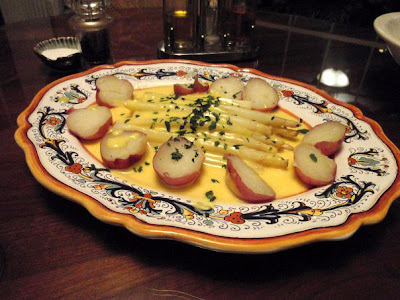This dish brings me back to my Vienna days: white asparagus and potatoes with hollandaise sauce. The appearance of asparagus in the markets of Vienna--as elsewhere--is a harbinger of Spring. Austrians (and Germans) have a thing for white asparagus. They prefer it to the green kind that is more familiar in most other places. In fact, ask for Spargel and they will assume you mean white asparagus, you should say Gruener Spargel, or "green asparagus" if you want the kind we're most familiar with. White asparagus are grown by keeping dirt mounded around the emerging stalk, depriving it of light. The plant cannot produce chlorophyll without light, thus there is no green color to the stalks. The flavor is more delicate, and the flesh more tender, than regular asparagus. (The same light deprivation technique is used to keep Belgian endive white as well.)
Anyway, this is another dish of utter simplicity to make, but quite beautiful to behold. Start by steaming some baby potatoes. While the potatoes are steaming, cut the bottom ends off the asparagus, peel them (but avoid the tender tips) and boil them, either in a skillet or in a asparagus cooker filled to an inch or two with water, for 5-10 minutes, depending on how thick they are and how crisp you like them. (Come to think of it, I suppose you could boil the potatoes in the same skillet where you are boiling the asparagus, in which case add the potatoes about 5-10 minutes before as they take longer to cook.)
In any event, when both the asparagus and potatoes are just about the way you like them, make the hollandaise sauce by placing two or three egg yolks in a bowl that is sitting above a pot of simmering water (in French this is called a bain marie), add the juice of half a lemon and a bit of salt and whisk briskly until the eggs are quite frothy. As they heat up, they will begin to thicken. As this happens, quickly begin to add a 1/2 cup of butter, which you will have melted separately, bit by bit, as you continue to whisk. As each bit of melted butter is absorbed by the egg, add a bit more butter, whisking all the time, until you have a nice creamy sauce. Add hot water to thin out the sauce if need be and remove from the heat. (TIP: Make sure to regular the heat so that it is at the simmer. If it gets too hot, the eggs will scramble rather than thicken. If you see this beginning to happen, you can take it off the heat immediately and add a drop of lukewarm water to cool things off, then continue.)
Transfer the asparagus and potatoes to a serving dish (making sure they are well drained--you don't want water on the dish!) and pour over the hollandaise sauce. (You will need to move quickly here, as the residual heat of the bowl will continue to thicken the sauce. If it becomes too thick, whisk in a bit more hot water.) Sprinkle some finely chopped parsley over the dish and serve immediately. Wash down with white wine. Mahlzeit!
NOTES: Those of you who have ever made mayonnaise at home will immediately see the similarities between the two sauces, the main difference being that mayo is made with oil while hollandaise is made with melted butter. In the latter case, to allow the egg yolk and butter to emulsify properly, you need to keep things warm but not hot. The need for temperature control makes hollandaise a bit more challenging to make than mayo.
Obviously, the egg yolks do not fully cook when you make hollandaise from scratch, so if you have qualms about uncooked eggs (salmonella and all that) I suppose you can use hollandaise sauce from a jar, although I have no idea if it's any good. There are also some recipes for mock hollandaise around. I haven't tried them so can't say much about them.
I won't try to sell this dish as healthful, as the hollandaise sauce, made from egg yolks and butter, is something of a cholesterol bomb. But I must say, it looks and tastes wonderful--so why not splurge once in a while?
